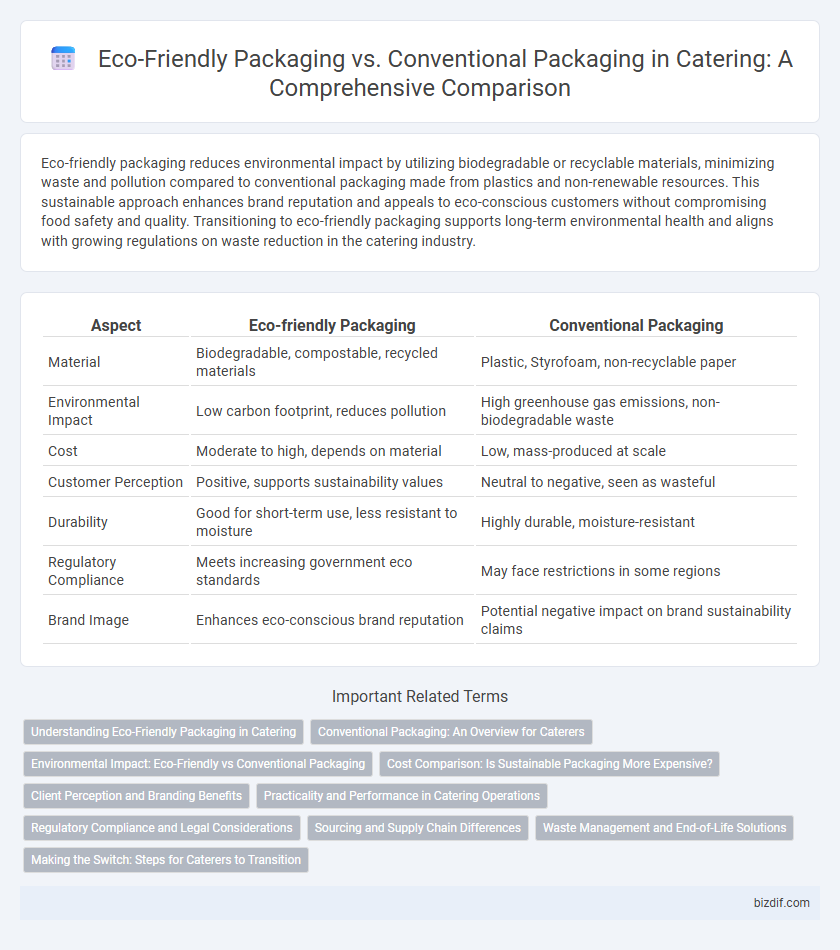Eco-friendly packaging reduces environmental impact by utilizing biodegradable or recyclable materials, minimizing waste and pollution compared to conventional packaging made from plastics and non-renewable resources. This sustainable approach enhances brand reputation and appeals to eco-conscious customers without compromising food safety and quality. Transitioning to eco-friendly packaging supports long-term environmental health and aligns with growing regulations on waste reduction in the catering industry.
Table of Comparison
| Aspect | Eco-friendly Packaging | Conventional Packaging |
|---|---|---|
| Material | Biodegradable, compostable, recycled materials | Plastic, Styrofoam, non-recyclable paper |
| Environmental Impact | Low carbon footprint, reduces pollution | High greenhouse gas emissions, non-biodegradable waste |
| Cost | Moderate to high, depends on material | Low, mass-produced at scale |
| Customer Perception | Positive, supports sustainability values | Neutral to negative, seen as wasteful |
| Durability | Good for short-term use, less resistant to moisture | Highly durable, moisture-resistant |
| Regulatory Compliance | Meets increasing government eco standards | May face restrictions in some regions |
| Brand Image | Enhances eco-conscious brand reputation | Potential negative impact on brand sustainability claims |
Understanding Eco-Friendly Packaging in Catering
Eco-friendly packaging in catering involves using biodegradable, compostable, or recyclable materials that minimize environmental impact while maintaining food safety and quality. These sustainable alternatives, such as plant-based plastics and recycled paper products, reduce waste and lower carbon emissions compared to conventional plastic or Styrofoam containers. Implementing eco-friendly packaging supports green initiatives and meets the increasing consumer demand for environmentally responsible catering solutions.
Conventional Packaging: An Overview for Caterers
Conventional packaging in catering primarily involves materials like plastic, Styrofoam, and aluminum, which are widely used due to their cost-effectiveness and durability. These materials offer excellent barriers against moisture and contamination, ensuring food safety and extending shelf life during transport and delivery. However, their environmental impact includes long decomposition times and reliance on non-renewable resources, prompting many caterers to evaluate sustainability trade-offs when choosing packaging options.
Environmental Impact: Eco-Friendly vs Conventional Packaging
Eco-friendly packaging significantly reduces environmental impact by utilizing biodegradable, recyclable, or compostable materials that minimize landfill waste and lower carbon emissions. Conventional packaging often relies on single-use plastics and non-renewable resources, contributing to pollution, resource depletion, and extended decomposition periods. Switching to sustainable packaging solutions helps caterers meet eco-conscious consumer demand while supporting global efforts to reduce environmental degradation.
Cost Comparison: Is Sustainable Packaging More Expensive?
Sustainable packaging often has a higher upfront cost compared to conventional packaging due to the use of biodegradable materials and eco-friendly manufacturing processes. However, long-term savings arise from reduced waste disposal fees and potential tax incentives for companies adopting green practices. When factoring in environmental benefits and brand value, eco-friendly packaging can be a cost-effective option despite initial expenses.
Client Perception and Branding Benefits
Eco-friendly packaging enhances client perception by signaling a commitment to sustainability, which increasingly influences consumer choices in the catering industry. Brands adopting biodegradable or recyclable materials differentiate themselves, fostering loyalty and positive word-of-mouth. This strategic shift not only aligns with environmental values but also boosts brand reputation and market competitiveness.
Practicality and Performance in Catering Operations
Eco-friendly packaging in catering offers advantages such as biodegradability and reduced environmental impact while maintaining durability for transporting hot and cold foods. Conventional packaging typically provides superior moisture resistance and structural integrity, ensuring reliable food protection during large-scale service. Balancing sustainability with practicality requires selecting eco-friendly materials that meet performance standards for insulation, strength, and food safety in diverse catering conditions.
Regulatory Compliance and Legal Considerations
Eco-friendly packaging in catering aligns with emerging regulatory standards aimed at reducing environmental impact, ensuring compliance with laws such as the EU Single-Use Plastics Directive and the U.S. EPA's Sustainable Materials Management Program. Conventional packaging often faces stricter regulations due to its reliance on non-biodegradable materials, leading to potential legal liabilities and increased disposal costs. Embracing biodegradable, recyclable materials not only meets current legal requirements but also prepares businesses for imminent regulatory changes targeting sustainability in food service operations.
Sourcing and Supply Chain Differences
Eco-friendly packaging sourcing prioritizes renewable, biodegradable materials sourced from sustainable farms or recycled content suppliers, reducing environmental impact throughout the supply chain. Conventional packaging relies heavily on petroleum-based plastics and non-renewable raw materials, often sourced globally with higher carbon footprints and less transparency in supplier practices. Sustainable supply chains for eco-friendly options emphasize local sourcing, ethical labor, and minimal waste, contrasting with conventional packaging's complex, cost-driven logistics dominated by mass production and long-distance shipping.
Waste Management and End-of-Life Solutions
Eco-friendly packaging significantly reduces waste by using biodegradable or compostable materials that decompose faster than conventional plastics, diminishing landfill accumulation. Waste management systems benefit from eco-friendly solutions as they promote recycling and composting, lowering environmental pollution and resource consumption. Conventional packaging contributes heavily to non-biodegradable waste, creating challenges in waste disposal and increasing reliance on incineration or landfill, which release harmful emissions and persist in the environment for centuries.
Making the Switch: Steps for Caterers to Transition
Caterers aiming to switch from conventional packaging to eco-friendly options should start by researching biodegradable and compostable materials that meet food safety standards. Evaluating suppliers who offer sustainable packaging solutions is essential to ensure cost-effectiveness and quality. Training staff on proper handling and educating clients about the environmental benefits can facilitate a smooth transition and enhance brand reputation.
Eco-friendly Packaging vs Conventional Packaging Infographic

 bizdif.com
bizdif.com